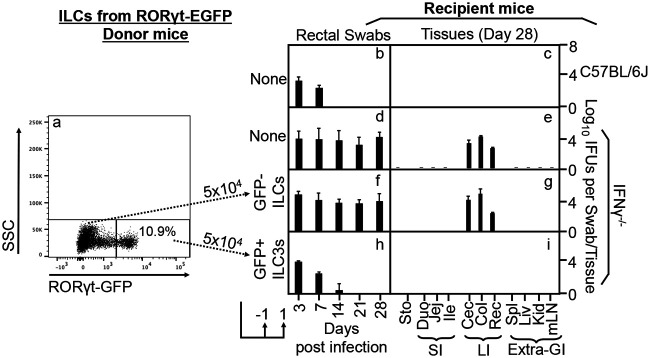FIG 7.
Adoptive transfer of RORγt GFP+ ILC3s but not RORγt GFP− non-ILC3s from the mouse intestinal lamina propria for restoring IFN-γ−/− mice to gain colon resistance to colonization by IFN-γ-susceptible mutant Chlamydia. (a) RORγt GFP+ ILC3s and RORγt GFP− non-ILC3s were sorted from intestinal lamina propria lymphoid cells after excluding dead and lin+ (positive for CD3, Ly6G/Ly6C, CD11b, CD45R/B220, and TER-119) cells as donor cells for adoptive transfer to IFN-γ-deficient mice. The transfer was carried out twice with 5 × 104 cells each and 1 day before and 1 day after infection, respectively, as indicated at the bottom. SSC, side scatter. (b to i) The IFN-γ-susceptible mutant Chlamydia strain (clone G28.51.1) was used to infect groups (n = 3) of C57BL/6J mice (b and c) or IFN-γ−/− mice without (d and e) or with transfer of RORγt GFP− non-ILC3s (f and g) or RORγt GFP+ ILC3s (h and i). On days 3 and 7 and weekly thereafter after inoculation, rectal swabs were taken (b, d, f, and h), or on day 28, mouse tissues were harvested (c, e, g, and i), as indicated along the x axis, for monitoring live chlamydial organisms (see the Fig. 1 legend for tissue name abbreviations). The yields of chlamydial organisms from swabs or tissues are expressed as log10 IFU per swab or tissue, as shown along the y axis. Note that adoptive transfer of ILC3s but not non-ILC3s conferred large intestinal resistance to mutant Chlamydia colonization in IFN-γ−/− mice. *, P < 0.05 (by a Wilcoxon rank sum test [areas under the curve between IFN-γ−/− mice transferred with RORγt GFP− non-ILC3s and those transferred with RORγt GFP+ ILC3s]). Data were acquired from two independent experiments.

